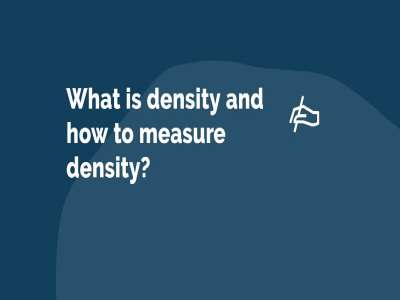What is density and how to measure density?

Densities are very vital in various uses. But what is density? You can refer to density as the mass of any given substance per its unit volume. When thinking about density, you will have to look at it in terms of a relationship. It isn't easy to measure or perceive density directly since it's a relation between the weight or mass of a given unit of a substance and the volume of that particular unit.
Every day, you interact with materials and substances. Sometimes, you are even required to determine the weight of such materials with accuracy. That's why it's essential to know how to measure density. Measuring the density of any given material requires you to infer from the relationship of the volume and mass.
You may also look at a density from the perspective of what makes something sink or float. After mixing two or even more substances, the dense substance will sink to the bottom. On the other hand, the less dense substance will be buoyant hence floats on the top. So, when doing business, it will be vital to learn how to measure density to avoid any losses that may arise due to inaccurate densities.
How to measure the density
In many natural sciences, measuring density involves taking the mass of a substance and dividing it by its volume. That means you have to measure the volume and mass of such a substance separately to find density. Once you get the measurements of the two, you can then calculate the density by dividing the mass of the substance by the volume.
Since you need to first get the mass and volume of the material you intend to determine its density, there are various laboratory tools you may use.
Use of a scale
You can obtain the mass of a substance very easily. All you need is to use the electronic balance of a scale to get the weight of any given object. The measurement of mass is represented in grams or ounces. Make sure to measure the weight of the container first when measuring the mass of a liquid. After that, you can stare at your scale before adding your liquid.
Using graduated cylinder to measure the volume
In the process of learning how to measure density, the volume is another aspect of a substance or object you will have to determine. When dealing with an irregular object, you can simply immerse it in water and get the amount of water displaced. That way, you can easily find the volume of such an object accurately.
Ensure to get a large enough graduated cylinder that can hold your object and enough water to fully immerse your object in it. A graduated cylinder will give you the volume of liquid by just pouring it into an empty cylinder. You should avoid using a biker to determine volume. The scale on the side of a biker can be less accurate compared to the one on a graduated cylinder.
Calculating density
You now have the mass and volume of the objects that you want to measure their density. That makes it easy to find density through a simple calculation! Just take the mass and then divide it by volume to determine the density.
Use of hydrometer to find the density
Do you deal with liquids and want to know how to measure the density of such liquids? You can use a hydrometer. Density may come into play when it comes to fluids and flotation since denser objects sink into a less dense fluid. Besides, the less dense object will always float on a fluid with greater density.
A hydrometer is designed to measure the density of liquids. When using a hydrometer, you will not have to measure volume using a graduated cylinder and go on to weigh your liquid to find its mass. The hydrometer floats at different levels within liquids based on their densities.
Factors that influence the measurement of density
There are important things to keep in mind when learning how to measure density. The accuracy of density can be affected by various factors. These includes
Temperature
A slight change in temperature as low as 0.1 may have an effect on the density measured. Temperature affects the space required for atoms to fit in a molecule. Increasing temperatures raise the vibration and make the atoms move far apart, which reduces the density value.so, if the temperature goes up, the volume rises, resulting in lowered density.
Air bubbles and impurities
The presence of impurities or even a single air bubble affects the density of the substance being measured. An air bubble or slight contamination gives inaccurate density results.
The viscosity of the substance
While the viscosity of fluid doesn't have a direct relationship with density, it can affect the density determination of a given substance based on the method applied.
Conclusion
Many applications of density measurements exist. But you will have to know to measure density to promote accurate application. To obtain accurate density, you need to measure the mass and volume of your substance and then divide mass by volume. If you are dealing with liquids, you can simply use a hydrometer to determine density without measuring the mass or volume of the substance you seek to determine its density.
- Comment
- Posted by Naman Modi